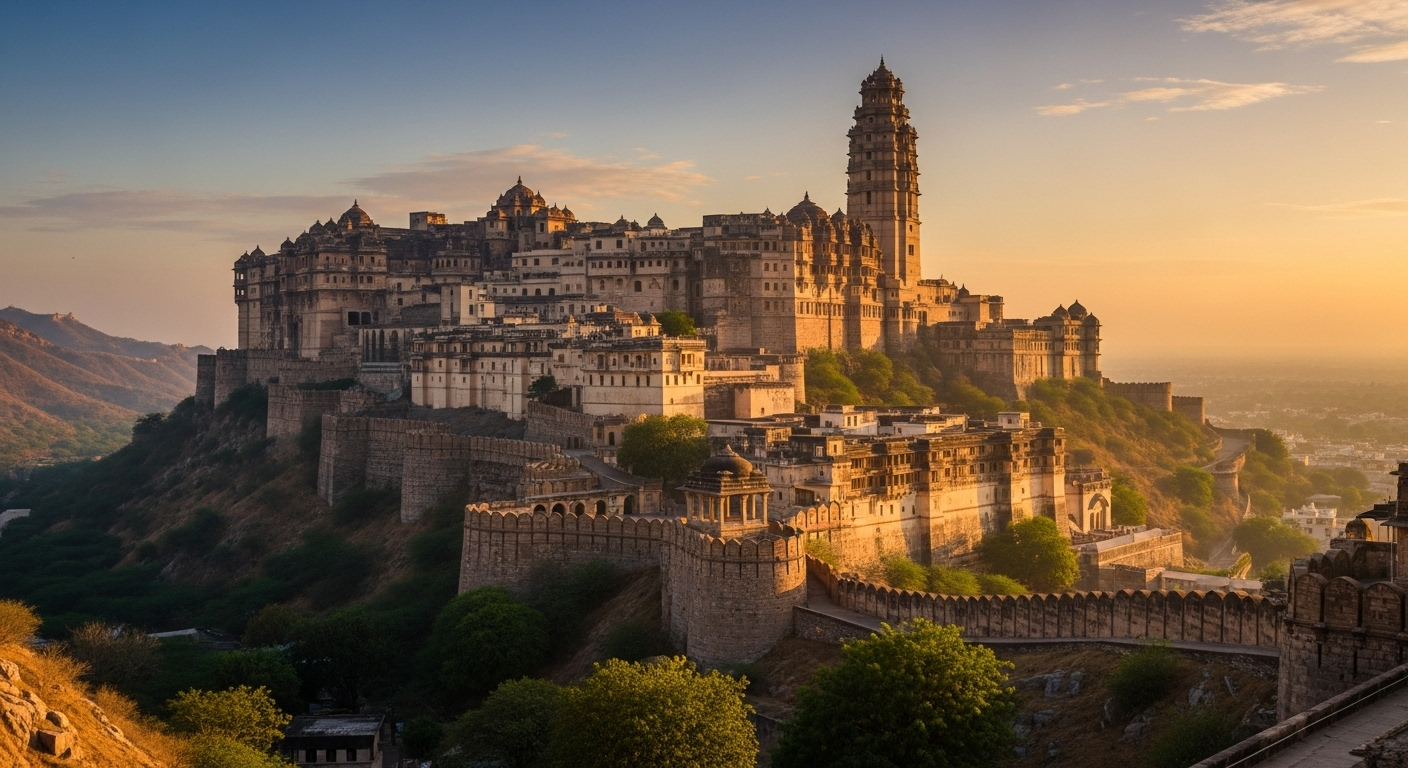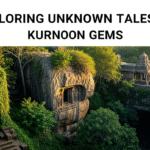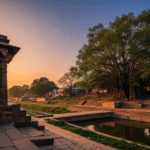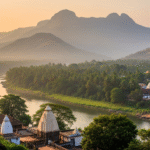The hidden history of Chittorgarh is full of mystery. Most people who see the fort don’t know about the old stories it keeps. These stories give Chittorgarh a magical feel.
Chittorgarh is more than a city. It’s full of stories of bravery and beauty. The tall walls tell tales of Rajput heroism. These tales are everywhere in the city.
In Chittorgarh, old ruins and traditions tell a rich story. Every stone in the city has a story from the past. These stories help us understand what India is today.
Key Takeaways
- Discover Chittorgarh’s past, brimming with unprecedented sagas.
- Grasp the city’s historical significance through its resilient spirit and cultural legacy.
- Witness the time-honored traditions and stories etched into the city’s historical landmarks.
- Reveal the depths of Chittorgarh’s hidden history, long obscured from common knowledge.
- Embrace the impact of Chittorgarh’s historical legacy on India’s collective heritage.
The Indomitable Fortress of Chittorgarh
Chittorgarh Fort is a mark of Rajasthan’s history and Rajput bravery. It is known for its huge size and deep history. The fort shows the important events of Chittorgarh’s past and its amazing design.
This fort is a UNESCO World Heritage site. It’s famous for its beauty and size. It also stands as a symbol of Rajput pride. Inside its walls are stories of smart building and brave fights. These are key parts of Chittorgarh’s history.
Architectural Marvels of the Chittorgarh Fort
The architecture of the fort is stunning. It shows the skills and creativity of the Rajputs. The main sights are the Vijay Stambha and Kirti Stambha. They are signs of Rajput power in war and culture. The detailed carvings and strong building methods show their knowledge of building and design.
The Siege Legends and the Pride of Rajputana
Chittorgarh’s story includes tales of courage and sacrifice during sieges. One story is about Rani Padmini. She chose to die by fire instead of being caught. Another is of Maharana Pratap fighting off invasions. These stories have made the fort a symbol of Rajput fight and honor. They remind us of their fearless spirit.
Exploring the Ancient Ruins of Chittorgarh
Chittorgarh’s landscape is full of history. It has many Chittorgarh historical landmarks that draw people’s interest. Walking through it tells stories of courage and great building skills. They mean a lot to locals and Indian history.
The Chittorgarh Fort is a key site of bravery. It is one of India’s biggest forts and a UNESCO World Heritage Site. Here, stories of heroism and love from Rajput history come alive. Travelers step back in time among old buildings and temples.
The ruins share many Chittorgarh historical discoveries. These insights show how people lived centuries ago. For history buffs, Chittorgarh is like an outdoor museum. It showcases the Rajputs’ grandness and their impact on the area’s design and culture.
- The immensity of Chittorgarh Fort with its numerous gates and towers
- Vijay Stambha and Kirti Stambha, epitomes of victory and fame
- Ruins of the Rana Kumbha Palace, where tales of royal exploits and everyday life merge
- The intricate carvings and serene ambience of the Meera Temple
These sites help us learn more about Chittorgarh’s history. They are key for studies and saving Chittorgarh historical landmarks. It’s about keeping the past alive and celebrating human spirit and creativity.
| Location | Importance | Historical Significance |
|---|---|---|
| Chittorgarh Fort | Centrepiece of Rajput military history | Site of numerous historical battles and royal residence |
| Vijay Stambha | Symbol of Victory | Constructed by Maharana Kumbha to commemorate his victory over Malwa and Gujarat |
| Meera Temple | Spiritual significance | Famous for its association with Saint Meera Bai, an ardent devotee of Lord Krishna |
Visiting Chittorgarh’s ancient ruins takes us back in time. These Chittorgarh historical discoveries make us understand more. They also link us with the past that has shaped our culture today.
Mysteries of the Meera Temple
The Meera Temple in Chittorgarh is more than a place for praying. It’s a key to history and spirit. Linked to Meerabai, a devoted follower of Lord Krishna, it shows love and courage. The temple is a part of Chittorgarh historical secrets. It holds many years of spiritual stories.
Inside its walls, the Meera Temple shares spiritual traditions with visitors. It’s built in Hindu and Jain styles. This design shows off the area’s cultural heritage and skills from the past.
| Aspect | Description | Significance |
|---|---|---|
| Architecture | Intricate carvings and Hindu-Jain influences | Reflects the artistic synthesis and religious tolerance of the period |
| Founding Myth | Associated with Meerabai’s life and her miracles | Symbolizes eternal devotion and the power of faith |
| Cultural Impact | Inspiration for many literary and musical works | Continues to influence spiritual and cultural expressions in Chittorgarh |
| Visitor Experience | Spiritual ambience and engaging narratives | Offers a profound, introspective visitor experience |
The temple shares Meerabai’s steadfast love for Lord Krishna. It keeps the spirit of love timeless and wide. It stands as a pillar in discovering Chittorgarh historical facts. Its story reaches out to all, calling historians, worshippers, and travelers to explore its secrets.
Uncovering the Hidden history of Chittorgarh
Chittorgarh is more than just ruins and amazing buildings. It’s full of stories not often told. Exploring its history shows us not just battles but also the lives of people mostly forgotten.
Chronicles Lost in Time: Unrecorded Battles and Tales
Chittorgarh has unknown stories hidden within its huge forts. These stories aren’t in our textbooks. They give a special look into events that shaped its culture and society.
These silent tales show the fort witnessed many unrecorded events. These events, even if not written down, are key to understanding Chittorgarh’s past.
The Essence of Chittorgarh in Folklore and Ballads
The spirit of Chittorgarh lives in its folk stories and songs. They tell about its greatness and sadness. These stories connect visitors with the past people of these lands.
To really get Chittorgarh, you must listen to the elders sing. Their songs reveal history not found in books.
In the end, while famous tales of bravery are well-known, it’s the smaller stories that are truly captivating. These stories, even if not as famous, help us see the full picture of Chittorgarh’s history.
The Enigma of Rana Kumbha Palace
Rana Kumbha Palace in Chittorgarh is a major landmark. Its stories and design captivate many people. Inside, tales of past times whisper through the air.
This palace’s beauty hides secrets and mystery rooms. These have sparked many Chittorgarh historical mysteries. People from everywhere come to explore them.
The Architectural Grandeur and Secret Chambers
The palace is famous for its beauty and size. It has big halls and tall gates. Yet, its hidden rooms are most fascinating. People wonder about them a lot.
Legends Surrounding the Palace’s Haunting History
The palace also has spooky tales. Some say ancient royal spirits still roam there. Stories of strange noises and sights add to its mystery. This makes the palace very special to Chittorgarh.
| Feature | Description |
|---|---|
| Architectural Style | Gothic archways, intricate carvings, and robust fortifications |
| Historic Significance | Capital of Mewar under Rana Kumbha’s rule |
| Mysterious Elements | Hidden passageways and secret chambers believed to be escape routes or treasure vaults |
| Legends | Associated with hauntings and historical figures like Rani Padmini |
Exploring Rana Kumbha Palace shows us great Rajput architecture. It also takes us into a world full of history and mystery.
Chittorgarh’s Role in the Revolts and Resistance
The Chittorgarh fort is more than beautiful architecture. It shows Chittorgarh’s brave history, especially during fights and hard times. In Rajasthan, India, its strong walls tell stories of the area’s past. They remind us of courage, struggle, and sacrifice.
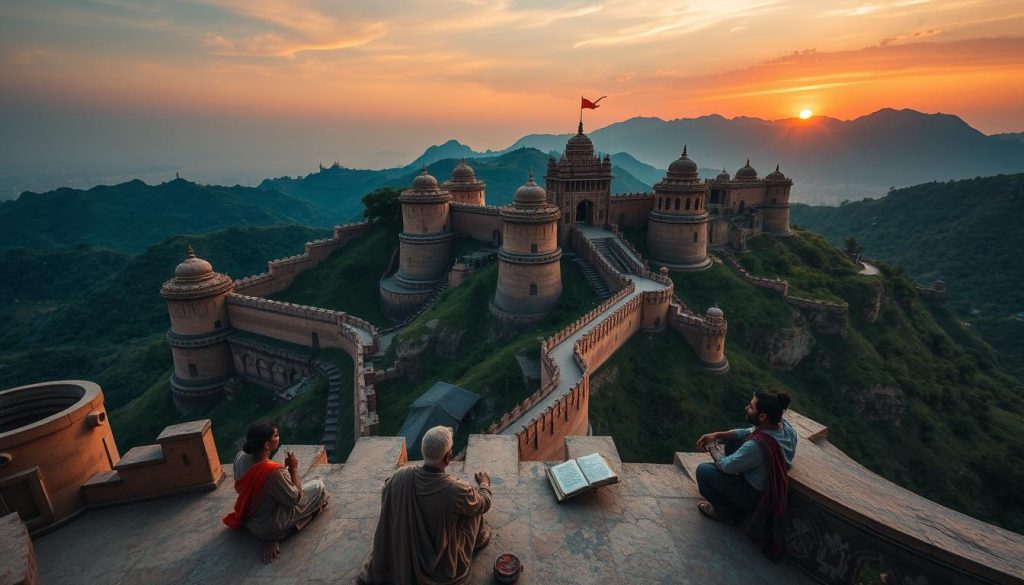
The fort’s story highlights Padmini’s famed stand. It shows Chittorgarh’s brave spirit against invaders. The Jauhar ritual, done by Rani Padmini and other women, is a sad yet brave tale. It shows their courage when facing sure loss.
The Great Stand of Padmini and the Jauhar Ritual
Queen Padmini’s story is one of bravery and tragedy. She did Jauhar to avoid capture by Alauddin Khilji, Sultan of Delhi. This shows Chittorgarh’s strong will to fight. It also shows how far the city’s people would go to keep their honor.
Defiants Against Invaders: Stories of Valour
Chittorgarh’s past is filled with brave fights against many attackers. It’s not just about Padmini, but many battles. Rajput warriors showed great courage there. Their stories tell us about their unbreakable spirit. It has left a lasting mark on India’s history.
Chittorgarh’s rebellions and fights teach us more than just history. They give us deep lessons about its people. They valued honor and freedom more than life. These tales are key to knowing Chittorgarh’s past. They also help us understand India’s rich culture back then and after.
Sacred Sites: The Spiritual Legacy of Chittorgarh
Chittorgarh’s spiritual heritage weaves into the city’s history. Each temple stands as a testament to deep spirituality. This blending of Chittorgarh spiritual heritage with Chittorgarh historical facts shows how religion and history shape the city.
The Meera Temple is a key spiritual site. It’s dedicated to Saint Meera who chose spirituality over royalty. This temple shows deep devotion and spirituality.
- The Kumbha Shyam Temple, tied to mystic rituals and history.
- The Kalika Mata Temple, from the 14th century, shows the city’s resilience and spirituality.
Chittorgarh also has Jain spiritual sites. The famous Gaumukh Reservoir is a serene Jain pilgrimage site. It reflects Jain values of peace. The city’s diverse religious sites showcase its deep spirituality.
Spiritual sites offered solace and strength during the city’s sieges. There’s a profound link between the city’s fortresses and sacred places. This link shows the interdependence of military and spiritual history.
Today, these places are worship sites and culture capsules. They preserve ancient rituals. Thus, they keep Chittorgarh’s spiritual legacy alive for locals and pilgrims.
Chittorgarh historical discoveries and Excavations
Scientists are always digging in Chittorgarh. They find things telling us about India’s past. These finds show how people lived there long ago.
New Findings Shedding Light on Ancient Civilization
Chittorgarh keeps showing its history with each new discovery. Among these, items from the Mauryan period have been found. This proves that Chittorgarh was important early on, during a time known for good leadership and big ideas.
The Unravelling of Time: Artefacts and Inscriptions
Old writings and items help tell Chittorgarh’s story. They show us the life and power of its past people. This lets us understand how Chittorgarh grew into a famous city.
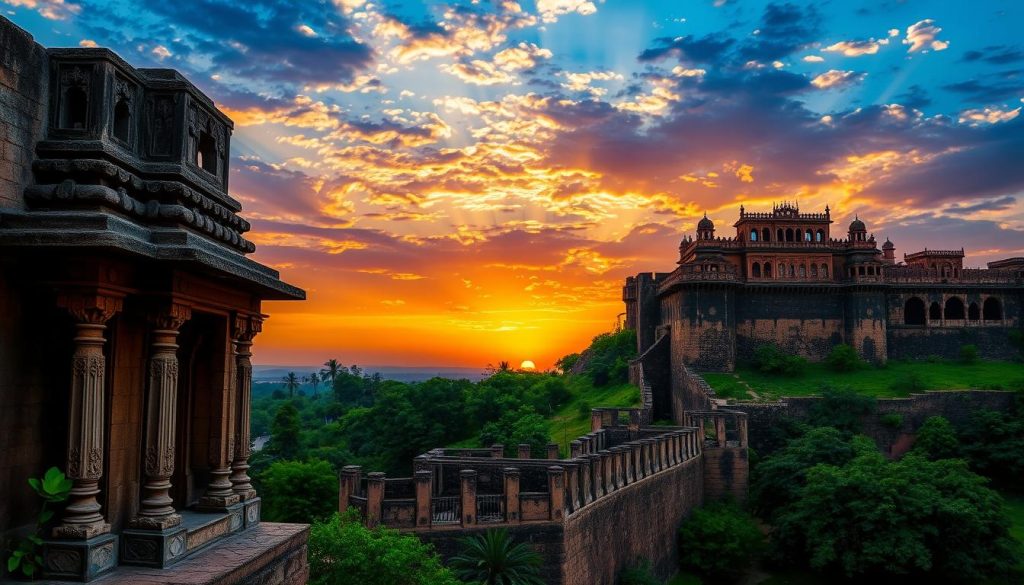
When we look at these ancient items, they remind us of other historical places in India. For more adventure, check out vintage car museums and beautiful trails, with lots of cool stuff to see.
| Artifact | Period | Significance |
|---|---|---|
| Mauryan Coins | Mauryan Period (322–185 BCE) | Evidence of trade and economic conditions |
| Inscribed Stones | 14th Century | Chronicles battles and governance |
| Architectural Remnants | Various Periods | Insights into architectural styles and cultural influences |
The ongoing digs in Chittorgarh keep pulling in both history buffs and tourists. This adds more to what we know of India’s history. It shows Chittorgarh’s big role in India’s stories.
Legendary Tales from the Vijay Stambha and Kirti Stambha
The Vijay Stambha and Kirti Stambha are more than just Chittorgarh historical landmarks. They are pillars of India’s rich heritage. These towers, in Chittorgarh Fort, tell stories of courage and spirit. They are key in sharing Chittorgarh historical events.
The ‘Tower of Victory,’ or Vijay Stambha, was built by Maharana Kumbha in the 15th century. It celebrates his win over the Sultan of Malwa. This architectural wonder also serves as a historical record. It has inscriptions on battles and victories. The tower is 37.19 meters high. It is covered in carvings of gods and goddesses, showing divine roles in human fights.
The Kirti Stambha stands shorter at 22.92 meters. It honors Adinath, the first Jain prophet, symbolizing peace and wisdom. Jijaji Rathod, a Jain trader, built it. It features beautiful carvings of Jain gods, showing the community’s faith and artistry.
Key Distinctions Between the Vijay Stambha and Kirti Stambha
| Tower | Purpose | Religious Significance | Historical Significance | Height | Inscriptions |
|---|---|---|---|---|---|
| Vijay Stambha | Martial Triumph | Hindu Iconography | Commemorates victory of Maharana Kumbha | 37.19 meters | Battle records, victories |
| Kirti Stambha | Spiritual Enlightenment | Jain Teachings | Cultural and religious diversity affirmation | 22.92 meters | Jain principles, religious motifs |
These towers do more than just stand tall. They inspire and teach visitors about history. The Vijay Stambha and Kirti Stambha remain symbols of India’s deep past. Historians, architects, and travelers come to see them. Their stories are grand and moving.
Chittorgarh’s Influence on Regional Art and Culture
Chittorgarh’s history is not just in books. It is in its art and culture too. This historic city is known for its bravery. It has a big impact on the region’s artistic traditions. This includes visual and performing arts.
The Influence of Chittorgarh on Rajasthani Miniature Paintings
Rajasthani miniature paintings are famous for their bright colors and details. They are inspired by Chittorgarh’s history. These artworks show battles and life at court. They let us see the city’s grand past. The colors and strokes of these paintings tell a story. It’s a visual story of the city’s culture.
The Folk Music and Dance of Chittorgarh: A Cultural Treasure
Folk music and dances share tales of Chittorgarh’s past. These are more than just fun. They show the cultural identity and history of the area. The music and the Ghoomar dance celebrate Chittorgarh’s legacy.
These cultural displays show how Chittorgarh’s tales have influenced local traditions. They help keep Chittorgarh culture alive through the years.
The influence of Chittorgarh on art goes beyond the local area. It inspires people all over the world. This makes it a key cultural spot in India’s art scene.
Conclusion
Rajasthan is like a colorful tapestry with its grand forts and lively festivals. It shows us a beautiful picture of its culture. Chittorgarh’s fort shows the courage and strength of the Rajput people. This city’s history and the stories in its forts speak of a time filled with honor.
People from all over the world visit Rajasthan to see its beauty and learn about India’s past. Places like Fateh Sagar Lake and the Brahma Temple offer peace and wonder. The stories of Chittorgarh’s forts add to the charm of Rajasthan, making it a key cultural and historical site.
Chittorgarh, and Rajasthan as a whole, light the way to India’s rich and varied past. They inspire us to learn about and keep safe this heritage. The history of Chittorgarh is kept alive through its art and music, making sure its brave tales are honored for years to come.
FAQ
What historical significance does Chittorgarh hold?
Chittorgarh is a symbol of Rajput pride and courage. It tells the story of Rajasthan’s rich past. The Chittorgarh Fort shows the important battles and stories that have left a mark on India’s history.
Can you describe the architectural marvels of the Chittorgarh Fort?
The Chittorgarh Fort is full of amazing buildings. It shows the Rajput skill in design and beauty. The fort has towers, palaces, gates, and temples that show the greatness of Rajput architecture.
What are the siege legends associated with Chittorgarh?
Chittorgarh is famous for its brave stories. A key story is about Rani Padmini’s brave act during Alauddin Khilji’s siege. These tales show the Rajput culture of honor in tough times.
What can be discovered through the ancient ruins of Chittorgarh?
The ruins of Chittorgarh tell us how people lived, worshipped, and ruled there. Archaeology helps us learn about the city’s history and culture. We get to see how the city evolved over time.
What secrets does the Meera Temple in Chittorgarh hold?
The Meera Temple is dedicated to Meerabai. It is a place filled with devotion and mystery. The temple tells stories of Meerabai’s love for Lord Krishna and her challenge to norms.
What are some of the unrecorded battles and tales associated with Chittorgarh?
There are many stories from Chittorgarh not found in history books. These include battles, secrets, and daily life that are told through stories and songs. They are a big part of the area’s culture.
How does the architectural grandeur of Rana Kumbha Palace stand out?
The Rana Kumbha Palace is known for its big size, beautiful design, and secret passages. It shows the artistic skill of its time.
What legends exist about the haunting history of Rana Kumbha Palace?
Myths say that the Rana Kumbha Palace is haunted by spirits. These stories of betrayal and tragedy add to its mystery.
What role did Chittorgarh play in historical revolts and resistance?
Chittorgarh was key in fights against invasions. It stands for the courage of its people, shown in tales of Rani Padmini and warrior Maharana Pratap.
How is the spiritual legacy of Chittorgarh reflected in its sacred sites?
Chittorgarh’s spiritual past lives in its many temples. These places show the city’s religious life and history. They have kept the cultural spirit alive through time.
What new historical discoveries have been made in Chittorgarh?
New finds in Chittorgarh include artifacts, writings, and old buildings. These discoveries help us understand its trade, society, and government better.
What are the legendary tales connected to Vijay Stambha and Kirti Stambha?
Vijay Stambha and Kirti Stambha celebrate Chittorgarh’s history. The stories about these towers show the victories and values of its leaders.
How has Chittorgarh influenced regional art and culture?
Chittorgarh’s history inspires Rajasthani paintings and music. Its stories of bravery and heroism are seen in lively dances and songs.
